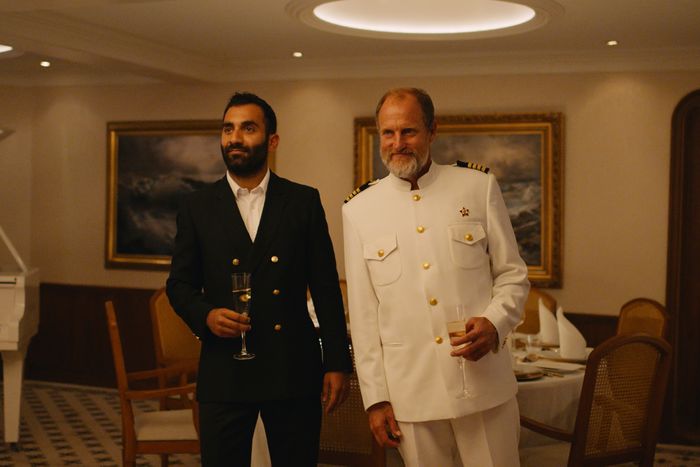
Satire is supposed to have a target, or so you’d think, but the megawealthy who run the world in Triangle of Sadness are such broadly drawn grotesques that it’s easy to imagine an audience of yacht-owning billionaires chuckling along to their antics while feeling nary a twinge of recognition. Truth be told, a variation on that scenario likely did take place when the film played at Cannes in May, where it went on to win the Palme d’Or, the second for writer-director Ruben Östlund, who first nabbed the top prize in 2017 for his museum-curator comedy The Square. Triangle of Sadness would hardly be the first film to showcase the tension between the exclusive circles of premier festivals and the serious-to-incendiary subject matter those festivals often traffic in — Todd Field’s Tár, also out this week, is about the downfall of a conductor faced with allegations of sexual misconduct, and it played at Lincoln Center, a few hundred yards from where James Levine served as music director of the Metropolitan Opera before being terminated for similar reasons. But Östlund’s slog of a film is exceptional in the distance it creates between the viewer and its characters and in how comfortable its attempts at causticity actually feel. It comes complete with an ending that should be bitterly dark and instead just comes across as a moue of indifference.
Östlund, a Swedish filmmaker with a talent for long takes and deadpan humor, has a well-established interest in gender roles and power dynamics, and the best scenes in Triangle of Sadness are ones in the beginning that explore both by way of the primary characters, a pair of models engaging in a somewhat transactional form of dating. Well, one of them is — Carl (Harris Dickinson), who was the face of a perfume campaign a few years ago but whose career is now on a downslope, wants a real relationship with Yaya (the late Charlbi Dean). Yaya, who’s still in demand, is more pragmatic about the fact that while she enjoys Carl’s company and being part of a famously photogenic couple, her 401(k) is going to take the form of eventually marrying someone rich. They have the cachet that comes with being professionally attractive but not much by way of actual cash, and during an argument over who’ll get the check at a restaurant, we understand that, in the circles in which they’ve gotten used to moving, they’re actually mismatched. Wealth can buy you the company of someone beautiful, but being beautiful only really gets you into the proximity of wealth. Carl and Yaya go back and forth over who usually pays (Carl) and who makes more (Yaya), but while their circular, amusingly passive-aggressive fight stretches from the table all the way back to their hotel room, at its center is something they can only really talk around, which is that they can’t afford the lives they’re living.
They can’t afford the luxury cruise they take in the second act, either, but it’s comped, courtesy of Yaya’s social-media following. Once Triangle of Sadness sets sail on the superyacht that consumes the film’s middle section, it gives up on any effort to make the people it puts onscreen resemble flesh-and-blood beings, with Carl and Yaya, the closest thing it has to actual humans, retreating into the backdrop to take selfies. Östlund sets up the ship’s strata. The passengers, on top, range from a couple of elderly British weapons manufacturers to an Eastern European “shit salesman” (Zlatko Burić) and his younger wife. The service staff appears to be mostly Scandinavian and is led by the relentlessly upbeat Paula (Vicki Berlin) in the absence of leadership from the depressive Captain Smith (Woody Harrelson, insufferable). Below them, like a racist layer cake, are a slew of non-white support workers who cook and keep the engine running and clean, and there is a lot of that to be done once the ship hits rough seas.
Östlund likes to use a static camera when shooting sequences of increasing discomfort, like the scene in which a passenger insists — because they’re “all equal” — that the young woman pouring her Champagne get into the hot tub alongside her. But there’s little reason to squirm when these characters feel less developed than figures in a comedy sketch. One of the latter — The Meaning of Life’s Mr. Creosote — could be the inspiration for the orgy of bodily fluids that eventually follows, though the Monty Python sequence had the good sense to last for a few minutes, and Triangle of Sadness goes on forever. It ambles on to a third act in which passengers and crew from the ship get marooned on an island, where the established hierarchies are turned on their head. While this section of the film offers a breakout turn from Filipina actress Dolly de Leon, who plays Abigail, one of the cleaning women, it’s also the most plodding and joyless, offering nothing except a cynical, paper-thin twist on what it means to hold power. I’ve seen Triangle of Sadness described as angry, and yet its foremost sentiment strikes me as one of smug nihilism in which the dynamics of the haves and have-nots can’t be escaped, only replicated with different parties on top. Capitalism, right? What a drag, but then what else can you do?
More Movie Reviews
- An Exploited Neighborhood, Seen Through Children’s Eyes
- Challengers Is Almost a Sexy Movie
- Zack Snyder’s Screensaver Space Opera Comes to an Uneventful End





